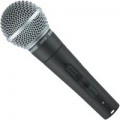Directional pattern
The polar pattern of a unidirectional microphone (see above). There are models with
DN switching.
By itself, such a diagram is a graph of sensitivity versus direction, built in the so-called polar coordinate system. For unidirectional models, there are three main options for the shape of the line on such a chart:
—
Cardioid. A chart shaped like an inverted heart symbol (hence the name). Microphones with these characteristics cover a fairly large area in front, which makes it difficult to filter out extraneous sound sources that are close to the main source. At the same time, they are completely insensitive to sound coming from the rear.
—
Supercardioid. These mics have a narrower front coverage than "classic" cardioid mics, making it easier to pick up directional sound. The downside of this is some (albeit rather low) sensitivity to sound coming directly from behind.
—
Hypercardioid. The hypercardioid pattern further narrows the microphone's sensitivity zone in the front (compared to the supercardioid pattern), but widens this zone in the back.
Rated resistance
Microphone AC impedance; this parameter is also called "impedance". This is one of the most important characteristics that determines compatibility with the amplifier or other device to which the microphone is connected: if the impedance is not optimal, there may be a loss in signal power. It has its own characteristics, depending on the purpose of a particular model (see above). So, for microphones used with computers, laptops, voice recorders and phones / tablets, the impedance may not be indicated at all — the characteristics of such models are selected in such a way as to ensure normal compatibility with the corresponding devices. But in professional audio equipment, special rules are used for selection; more details can be found in special sources.
Frequency range
The range of audio frequencies normally perceived and processed by a microphone.
The wider this range — the fuller the signal, the less likely that too high or low frequencies will be missed due to the imperfection of the microphone. However, in this case, it is worth considering some nuances. First of all: a wide frequency range in itself does not guarantee high sound quality — a lot also depends on the type of microphone (see above) and its frequency response, not to mention the quality of other components of the audio system. In addition, a large width is also not always really necessary. For example, for normal transmission of human speech, a range of 500 Hz — 2 kHz is considered sufficient, which is much narrower than the general range perceived by the human ear. This general range, in turn, averages from 16 Hz to 22 kHz, and also narrows with age. Do not forget about the features of the equipment to which the microphone is connected: it is hardly worth specifically looking for a model with an extensive range, if, for example, the amplifier to which it is planned to be connected severely “cuts off” the frequencies from above and/or below.
Features
—
Wireless connection. This feature is indicated for the so-called radio microphones — models in which the signal is transmitted wirelessly. Note that a radio microphone kit usually involves a receiver that is connected to an amplifier (or other sound processing device) in a classic wired way (see "Connection connectors"). However, the microphone itself is connected to the receiver via a radio channel.
—
Stereo recording. The ability to use a microphone to record sound in stereo format. This format assumes the presence of two channels, and for each of them the sound must be recorded separately; but the technical support of such a recording in different cases may vary. The most popular option is bi-directional microphones. However, in addition to this, this category includes paired sets for which the stereo recording function is directly claimed.
—
LPF (Roll-off). The presence of a low-pass filter in the design of the microphone (Roll-off is an alternative name for this function). This feature allows you to reduce the level of low frequencies in the signal produced by the microphone. This need may be due to two factors. Firstly, many extraneous noises are the sound of the wind, knocks on the device case, the surrounding background, etc. — are presented at low frequencies; by suppressing this range, you can significantly reduce the level of extraneous so
...unds “heard” through the microphone. Secondly, the LPF is useful for working with the so-called "proximity effect". This effect consists in the fact that when approaching the sound source, many models tend to increase the volume of the bass sound, and when removed, on the contrary, they fail the “bass”. By turning on Roll-off when approaching the sound source and turning it off when moving away, this effect can be smoothed out to a certain extent. For a number of technical reasons, this function is mainly used in condenser and electret microphones (see "Type"). Note that in advanced models, the low-pass filter can be made customizable and supplemented with an auxiliary ultra-low pass filter.
— Attenuator. The presence of an attenuator in the design of the microphone — a device that gradually attenuates the signal level at the output (a kind of opposite to an amplifier). This feature is useful when working with loud sound: by lowering the signal level, you can avoid overloading the system.
— Sensitivity adjustment. The presence of its own sensitivity control in the design of the microphone. This function allows you to adjust the signal level without using the controls in other components of the audio system — for example, to change the volume on the fly; this is quite convenient, since the microphone is usually at hand, and settings can be changed very quickly and without much hassle.
— Headphone volume adjustment. A separate knob for adjusting the volume of connected headphones (see "Headphone output"). Depending on the model, it can be placed both on the microphone itself and on the receiver for wireless connection. Anyway, this feature makes adjusting the volume more convenient: the control is at hand and the user does not need to reach for other devices or delve into the software settings.
— Mute the microphone. The presence of its own switch in the design of the microphone. In some use cases, it is not uncommon for situations where the microphone has to be constantly turned on and off. For example, during a concert, the number of performers may change, and it is better to turn off unused microphones; when communicating via Skype through a computer, sometimes you have to be distracted by conversations with others that the “computer” interlocutor does not need to hear, etc. Usually, muting the microphone is possible through the settings or control panel of the device to which it is connected; however, using your own switch is usually easier and faster, especially if you have to mute / unmute the sound frequently.
— Built-in memory. The presence of built-in data storage in the microphone eliminates the need to use external storage media to record sound. On-board storage is found in some models of advanced “lavaliers”, microphones for video cameras and voice recorders - i.e. in portable solutions with a view to comfortable work in the field.
— Switching DN. DN in this case means “directional pattern”, however, this function may mean switching not only between options for a unidirectional microphone (see “Directional Pattern”), but also between one-, two- and omnidirectional operation format (see “Directionality”). microphone"). Therefore, specific switching features and available options should be clarified for each model separately.
